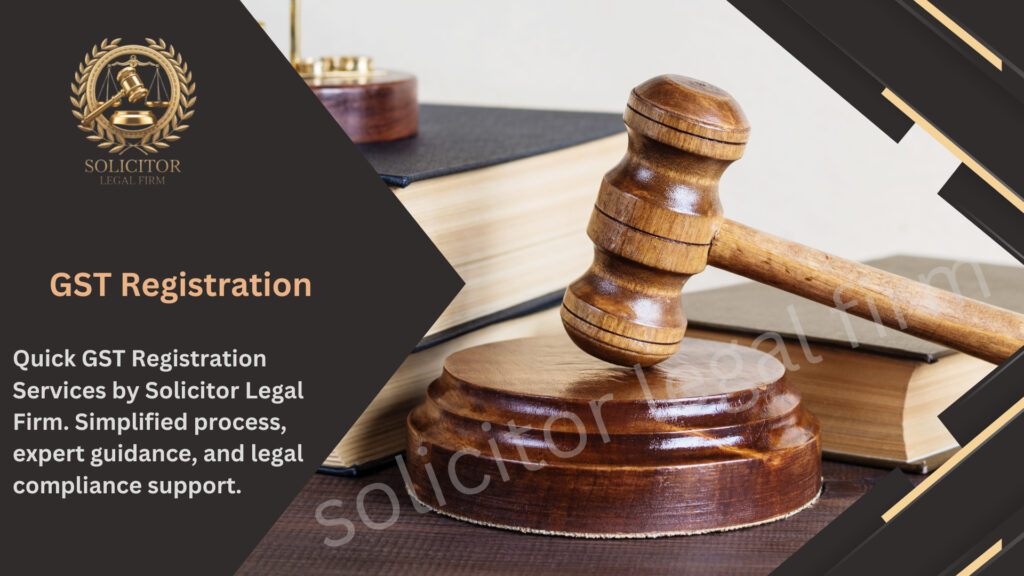GST REGISTRATION

INTRODUCTION:
GST registration is the process by which a taxpayer gets registered under Goods and Service Tax (GST) in the different types of GST registration as per their requirement. Once the registration process has been completed, the Goods and Service Tax Identification Number (GSTIN) is provided.
Businesses dealing in sales and supply of goods and services must complete GST registration under the rules prescribed by the Goods and Services Tax (GST) regime. Carrying out businesses without GST registration is considered an offense in specific cases and could attract a significant monetary penalty.
After GST registration, a 15-digit Goods and Service Tax Identification Number (GSTIN) is issued, acting as your identification number for all business operations, based on which GST will be levied and collected.
NOTE: If a business operates from more than one state, the taxpayer should obtain a separate GST registration for each state.
WHY GST REGISTRATION IS MANDATORY:
Any business in India whose aggregate turnover exceeds the threshold limit is liable to get registered. However, certain categories of businesses mentioned in Schedule III of the MGL are liable to get registered, irrespective of the threshold. A farmer is not considered a taxable person and is not liable for GST registration.
For companies involved in the supply of services, GST registration is mandatory if their annual turnover exceeds Rs 20 lakhs. For businesses dealing in the supply or sale of goods, GST registration is mandatory in case their annual turnover exceeds Rs 40 lakhs.
GST registration threshold is Rs 10 lakhs if you have a place of business in Arunachal Pradesh, Assam, Himachal Pradesh, Jammu & Kashmir, Manipur, Meghalaya, Mizoram, Nagaland, Sikkim, Tripura, or Uttarakhand.
Irrespective of turnover GST is mandatory in the following circumstances
Inter-state supplies
Supply of goods through an e-commerce portal
Service provider
Agent for registered principal
Liable to pay the reverse charge
Non-resident taxable person
Casual taxable person
Input service distributor
TDS/TCS deductor E-commerce operator
An online data access and retrieval service provider
BENEFITS OF GST REGISTRATION:
Boost the GDP in India:
GST is expected to increase government income by widening the tax base and increasing taxpayer compliance. GST is expected to boost India’s economy. It has a high position in the Ease of Doing Business Index. GDP is expected to rise by 1.5 percent to 2 percent. By establishing a level playing field, the GST will prevent tax cascading.
Beneficial especially for Small and Medium Enterprises (SMEs):
Small business owners are interested in analyzing the potential effects of GST T on their businesses. SMEs (Small and Medium Enterprises) is well-known as the economy’s principal growth engine and major contributors to GDP.
Bank Loans:
GST registration and return filing serve as proof of business activity and help a company establish a track record. Banks and non-bank financial institutions (NBFCs) lend to businesses based on information from GST returns. As a result, GST registration might assist you in formalizing your firm and obtaining credit.
E-Commerce:
GST registration is required to sell online and through online platforms such as Amazon, Flipkart, Snapdeal, Zomato, and others. Having a GST registration allows you to sell online.
Provide an input tax credit to customers:
All taxes paid on export goods or services, and input services used in the delivery of such goods or services, shall be repaid. Across the board input tax credit(ITC)system, the complete supply chain such a constant accessibility Input Tax Credits are available for a variety of goods and services at every level. You can issue taxable invoices now that your company is officially recognized. Buyers can then use input credit toward their purchases. This will help to expand the client base and increase the company’s competitiveness.
Benefit from a provisional refund:
The principle of only exporting the cost of goods or services, rather than taxes, would be followed. This will boost Indian exports, improving the country’s balance of payments position. Exporters will benefit from a provisional refund of 90% of their claims within seven days of receiving acknowledgment of their application, resulting in an improvement in cash flow position.
ELIGIBILITY FOR REGISTRATION UNDER GST:
Every person who was registered under an earlier law (i.e., Excise, VAT, etc) before the GST law came into effect.
Non-Resident Taxable Person making taxable supply.
Individuals who are required to pay reverse the charge.
All e-commerce operators.
Input service distributors and suppliers’ agents.
Persons engaged in making intra-State supplies in the States of Arunachal Pradesh, Manipur, Meghalaya, Mizoram, Nagaland, Puducherry, Sikkim, Telangana, Tripura, Uttarakhand.
Individuals who supply goods through an e-commerce operator.
Individuals providing database access and online information from outside India to people who live in India other than those who are registered taxable persons.
The person making any interstate supply.
Casual Taxpayers making a Taxpayer supply.
A business that is registered has been transferred to someone/demerged, the transferee shall take registration with effect from the date of transfer.
Persons who are required to deduct tax under section 51, whether or not separately registered under this Act; As per section 51 of CGST Act,2017 the Government may mandate: (a) a department or establishment of the Central Government or State Government; or (b) local authority; or (c) Governmental agencies; or (d) such persons or category of persons as may be notified by the Government.
DOCUMENTS REQUIRED FOR GST REGISTRATION:
Copy of PAN card
Copy of Aadhaar card
Proof of Business address
Passport size photo
E-mail id and Mobile number
Certificate of Incorporation /Business registration proof/Partnership deed (If any)
Authorization Letter/ Board Resolution
Digital Signature
Director’s/Promoter’s /Partners ID proof, address proof
Latest Electricity Bill (not older than 2 months from the date of GST registration)
Bank account statement and cancelled cheque
Any other documents depending upon the type of registration and the nature of business.
PENALTY IF GST REGISTRATION IS NOT OBTAINED:
Any taxable person who fails to obtain registration under GST is liable for a fine of Rs. 10,000 or the amount of tax evaded, whichever is greater as per Section 122 of the CGST Act.
PROCESS OF GST REGISTRATION:
Following is the process to register your GST
Step 1: Visit the GST Government website.
Step 2: Click Services > Registration > New Registration option.
Step 3: The following application form for registration under GST will be displayed. It is divided into two parts, Part A and Part B. The following “New Registration” page is displayed in Part A. Fill out the details in Part A of the form and click on “Proceed”
Step 4: On the subsequent OTP Verification page, enter the OTP you received on your mobile number and that on your email address. Please note that this OTP is valid only for only 10 minutes.
Step 5: Once you verify the application, Part A of the GST registration form is completed. Subsequently, the system automatically generates and displays a Temporary Reference Number (TRN). This TRN which is required for completion of registration under GST is valid for only 15 days.
Step 6: Fill out Part B of the form. You can open Part B of the GST registration form by clicking on the “My Saved Applications” tab. Enter the TRN generated and the captcha text as shown on the screen below.
Step 7: Once you click “Proceed”, the following verification page will be displayed. Enter the OTP received on your registered mobile number and e-mail id.
Step 8: Subsequently, the My Saved Applications page is displayed. Under the Action column, click the Edit icon as shown below.
Note: The status of the application for registering under GST is ‘Draft’ by default unless the application is submitted. Once the application is submitted, the status is changed to ‘Pending for Validation’.
Step 9: On the subsequent screen, the GST registration application form with the following tabs will be displayed. You need to select each tab and enter the relevant details. The following are the key tabs in the application form for GST registration:
Business Details
Promoter/Partners
Authorized Signatory
Authorized Representative
Principal Place of Business
Goods and Services
Bank Accounts
State Specific Information
Verification
Step 10: After successful verification of your GST application for registration, you will receive an acknowledgment within 15 minutes on your registered e-mail address and mobile phone number. Moreover, an Application Reference Number (ARN) receipt is sent to your e-mail address and mobile phone number.
CONCLUSION:
GST registration is the process by which a taxpayer gets registered under Goods and Service Tax (GST) in the different types of GST registration as per their requirement. Once the registration process has been completed, the Goods and Service Tax Identification Number (GSTIN) is provided.

